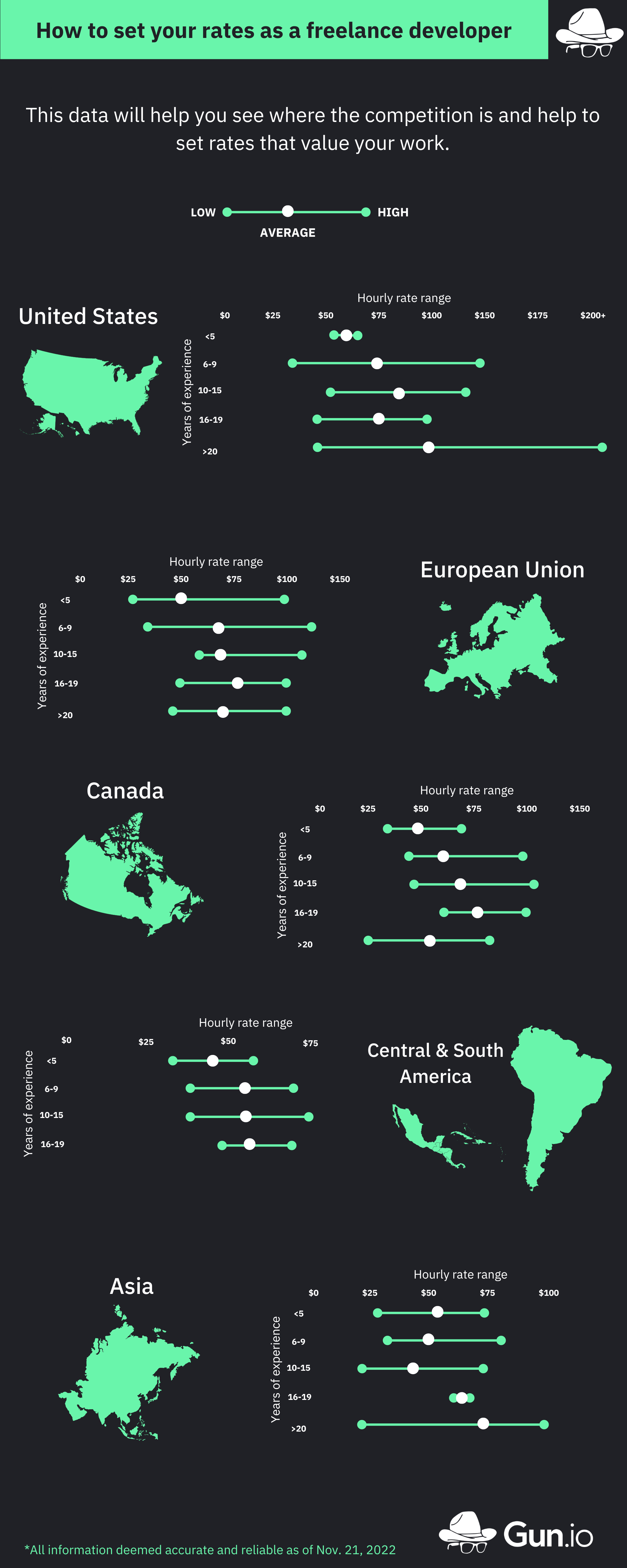
How to price yourself as a contract developer
When moving from full-time work to freelance, knowing how to price your contract developer rates can be a challenge. The good news is we’ve got the data to help you do it right!
We’re often asked by developers how to price contract work, whether it’s an hourly rate, a monthly retainer, or an annual salary. The answer – like most things in software – is usually, “it depends.”
Depends on what, though?
First and foremost, deciding how to price your software developer contract rates is going to depend on your personal financial situation and goals. Do you live in a high cost-of-living area? Have a family? Want to buy a new car next year?
These all take planning.
You also need to consider how much time you want to spend actually working. Aside from the obvious non-billable tasks (vetting clients, filing taxes, updating your website, etc.), you need to have the time to enjoy life. Freelancers can’t be working all the time, after all.
The second dependency is what kind of bargaining chips are on the table for any given client’s project. How rare is the combination of languages and experience they need? How dire is the situation when it comes to getting the project completed? What’s the potential ROI?
All of these things change on a case-by-case basis, which is why figuring out “perfect” contract developer rates is so challenging. These are just some of the reasons why it’s helpful to have an advocate like Gun.io helping to negotiate the contract’s final terms on your behalf.
Underneath it all, though, market trends will be the most solid foundation of rate negotiations.
Here at Gun.io, we use data from hundreds of contract developers who have been hired through our platform to help other developers navigate the murky waters of software developer contract rates. The averages here are banded together based on years of experience and general location.
It’s worth noting that we do not use one-size-fits-all answers, and neither should you. We like to look at this as a benchmark for rate-setting discussions.
If the skill set required by a client is particularly rare, or if the developer is particularly exceptional, or if the client needs it done, like, yesterday? Those are all good arguments for moving your rate right of average.
Another thing to note here is that these bands of averages are the developer compensation only, not client cost averages. When you hire someone, regardless of their department, the compensation is only one part of the total cost. The final numbers will always vary, but you have to take into consideration the type of hire (contract vs salaried), how you hired them (recruiters, ATS, job boards, etc.), tools and supplies, and so on.
Important notes about this data
In looking at the data below, you’ll notice that average hourly rates aren’t linear.
What that means is the average hourly rates that win opportunities on the platform don’t necessarily increase with the number of years of experience a developer has. There are no standard contract developer rates at $XX/hour based exclusively on the number of years you’ve been developing.
This can make it a little more difficult to say “My time is worth exactly this amount of money,” but also illustrates why we only recommend using our information as a guideline to determine how you set your rates. Urgency, the number of available developers who share your skillset, and other hire-specific factors can swing these averages significantly.
To help better understand the averages, we’ve added the number of developers hired in each cohort during the period in which this data was collected as the parenthetical.
Finally, it’s worth reiterating that pricing your contract developer rates is personal and complex. We’ve negotiated rates for developers upwards of $300 per hour, and can confidently say that the lowest rate does not always (or even often) win engagements on Gun.io.
If you’re an approved developer on the platform and want to have a conversation about pricing yourself well, we encourage you to reach out to a member of the Developer Relations team in Cantina!

| < 5 years | 6-9 years | 10-15 years | 16-19 years | > 20 years | |
| United States – LOW | $55 | $30 | $50 | $40 | $40 |
| United States – AVG | $60 | $73 | $87 | $74 | $96 |
| United States – HIGH | $65 | $150 | $140 | $100 | $300 |
| European Union – LOW | $25 | $30 | $60 | $50 | $40 |
| European Union – AVG | $50 | $64 | $68 | $75 | $63 |
| European Union – HIGH | $100 | $125 | $120 | $100 | $100 |
| Canada – LOW | $30 | $40 | $45 | $60 | $23 |
| Canada – AVG | $48 | $60 | $70 | $75 | $55 |
| Canada – HIGH | $70 | $100 | $110 | $100 | $85 |
| C./S. America – LOW | $32 | $35 | $35 | $45 | No data |
| C./S. America – AVG | $45 | $53 | $54 | $58 | No data |
| C./S. America – HIGH | $60 | $70 | $75 | $70 | No data |
| Asia – LOW | $28 | $30 | $20 | $70 | $45 |
| Asia – AVG | $56 | $48 | $38 | $70 | $72 |
| Asia – HIGH | $75 | $80 | $75 | $70 | $100 |



